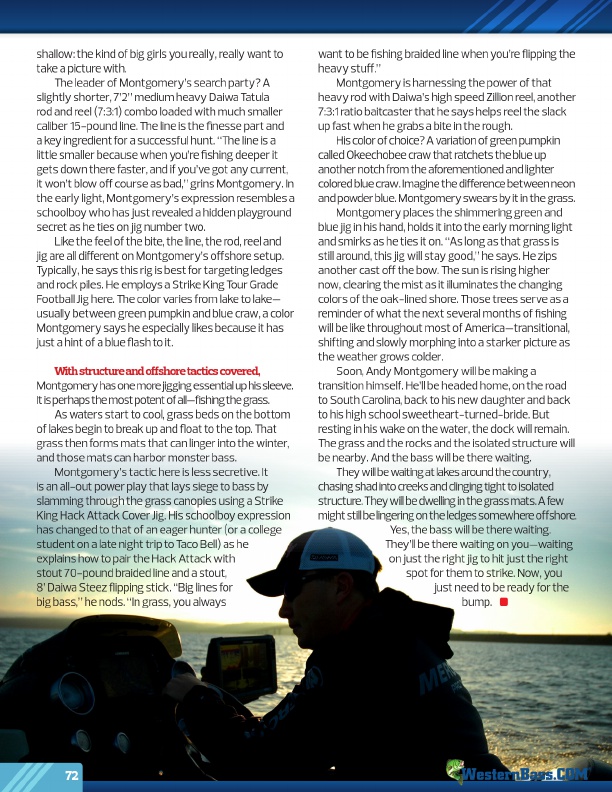
shallow: the kind of big girls you really, really want to take a picture with.
The leader of Montgomery’s search party? A slightly shorter, 7’2” medium heavy Daiwa Tatula rod and reel (7:3:1) combo loaded with much smaller caliber 15-pound line. The line is the finesse part and a key ingredient for a successful hunt. “The line is a little smaller because when you’re fishing deeper it gets down there faster, and if you’ve got any current, it won’t blow off course as bad,” grins Montgomery. In the early light, Montgomery’s expression resembles a schoolboy who has just revealed a hidden playground secret as he ties on jig number two.
Like the feel of the bite, the line, the rod, reel and jig are all different on Montgomery’s offshore setup. Typically, he says this rig is best for targeting ledges and rock piles. He employs a Strike King Tour Grade Football Jig here. The color varies from lake to lake— usually between green pumpkin and blue craw, a color Montgomery says he especially likes because it has just a hint of a blue flash to it.
With structure and offshore tactics covered, Montgomery has one more jigging essential up his sleeve. It is perhaps the most potent of all—fishing the grass.
As waters start to cool, grass beds on the bottom of lakes begin to break up and float to the top. That grass then forms mats that can linger into the winter, and those mats can harbor monster bass.
Montgomery’s tactic here is less secretive. It is an all-out power play that lays siege to bass by slamming through the grass canopies using a Strike King Hack Attack Cover Jig. His schoolboy expression has changed to that of an eager hunter (or a college student on a late night trip to Taco Bell) as he explains how to pair the Hack Attack with stout 70-pound braided line and a stout, 8’ Daiwa Steez flipping stick. “Big lines for big bass,” he nods. “In grass, you always
want to be fishing braided line when you’re flipping the heavy stuff.”
Montgomery is harnessing the power of that heavy rod with Daiwa’s high speed Zillion reel, another 7:3:1 ratio baitcaster that he says helps reel the slack up fast when he grabs a bite in the rough.
His color of choice? A variation of green pumpkin called Okeechobee craw that ratchets the blue up another notch from the aforementioned and lighter colored blue craw. Imagine the difference between neon and powder blue. Montgomery swears by it in the grass.
Montgomery places the shimmering green and blue jig in his hand, holds it into the early morning light and smirks as he ties it on. “As long as that grass is still around, this jig will stay good,” he says. He zips another cast off the bow. The sun is rising higher now, clearing the mist as it illuminates the changing colors of the oak-lined shore. Those trees serve as a reminder of what the next several months of fishing will be like throughout most of America—transitional, shifting and slowly morphing into a starker picture as the weather grows colder.
Soon, Andy Montgomery will be making a transition himself. He’ll be headed home, on the road to South Carolina, back to his new daughter and back to his high school sweetheart-turned-bride. But resting in his wake on the water, the dock will remain. The grass and the rocks and the isolated structure will be nearby. And the bass will be there waiting.
They will be waiting at lakes around the country, chasing shad into creeks and clinging tight to isolated structure. They will be dwelling in the grass mats. A few might still be lingering on the ledges somewhere offshore.
Yes, the bass will be there waiting.
They’ll be there waiting on you—waiting
on just the right jig to hit just the right
spot for them to strike. Now, you
just need to be ready for the
bump.
72 ®